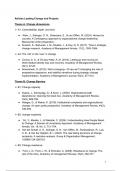Articles Leading Change and Projects
Theme A: Change dimensions
➢ A1: Controllability, depth, and time
● Klein, J., Solinger, O. N., Graamans, E., & van Olffen, W. (2024). Horses for
courses: A Contingency approach to organizational change leadership.
Manuscript under preparation.
● Kunisch, S., Bartunek, J. M., Mueller, J., & Huy, Q. N. (2017). Time in strategic
change research. Academy of Management Annals, 11(2), 1005-1064.
➢ A2: The ‘old’ vs the ‘new’ in change
● Conroy, S. A., & O'Leary-Kelly, A. M. (2014). Letting go and moving on:
Work-related identity loss and recovery. Academy of Management Review,
39(1), 67-87.
● Sonenshein, S. (2010). We're changing—Or are we? Untangling the role of
progressive,regressive, and stability narratives during strategic change
implementation. Academy of Management Journal, 53(3), 477-512.
Theme B: Change Barriers
➢ B1: Change capacity
● Sydow, J., Schreyögg, G., & Koch, J. (2009). Organizational path
dependence: Opening the black box. Academy of Management Review,
34(4), 689-709.
● Waeger, D., & Weber, K. (2019). Institutional complexity and organizational
change: An open polity perspective. Academy of Management Review, 44(2),
336-359.
➢ B2: change recipients
● Yin, Y., Mueller, J., & Wakslak, C. (2024). Understanding How People React
to Change: A Domain of Uncertainty Approach. Academy of Management
Annals, Vol. 18, No. 2, 712–754.
● Van der Schaft, A. H., Solinger, O. N., Van Olffen, W., Ruotsalainen, R., Lub,
X. D., & Van der Heijden, B. I. (2024). The role taking dynamics of change
recipients: A narrative analysis. Group & Organization Management,
10596011241265153.
➢ B3: Change resistance
● Ford, J. D., Ford, L. W., & D'Amelio, A. (2008). Resistance to change: The
rest of the story. Academy of management Review, 33(2), 362-377.
1
, ● van den Ende, L., & van Marrewijk, A. (2019). Teargas, taboo and
transformation: A neoinstitutional study of community resistance and the
struggle to legitimize subway projects in Amsterdam 1960–2018. International
Journal of Project Management, 37(2), 331-346.
➢ B4: Change spirals: Control vs collaboration spirals
● Sundaramurthy, C., & Lewis, M. (2003). Control and collaboration: Paradoxes
of governance. Academy of Management Review, 28(3), 397-415.
● Van Marrewijk, A. (2007). Managing project culture: The case of Environ
Megaproject. International Journal of Project Management, 25(3), 290-299
Theme C: Change tactics
➢ C1: Changing in steps
● Cummings, S., Bridgman, T., & Brown, K. G. (2016). Unfreezing change as
three steps: Rethinking Kurt Lewin’s legacy for change management. Human
Relations, 69(1), 33-60.
● Stouten, J., Rousseau, D. M., & De Cremer, D. (2018). Successful
organizational change: Integrating the management practice and scholarly
literatures. Academy of Management Annals, 12(2), 752-788.
➢ C2: Change logics: dialogical, diagnostic, cost-focus, people-focus
● Hastings, B. J., & Schwarz, G. M. (2022). Leading change processes for
success: A dynamic application of diagnostic and dialogic organization
development. The Journal of Applied Behavioral Science, 58(1), 120-148.
● Solinger, O. N., Joireman, J., Vantilborgh, T., & Balliet, D. P. (2021). Change in
unit‐level job attitudes following strategic interventions: A meta‐analysis of
longitudinal studies. Journal of Organizational Behavior, 42(7), 964-986.
➢ C3: Change templates: Management fashions
● Westphal, J. D., Gulati, R., & Shortell, S. M. (1997). Customization or
conformity? An institutional and network perspective on the content and
consequences of TQM adoption. Administrative Science Quarterly, 366-394.
● Canato, A., Ravasi, D., & Phillips, N. (2013). Coerced practice implementation
in cases of low cultural fit: Cultural change and practice adaptation during the
implementation of Six Sigma at 3M. Academy of Management Journal, 56(6),
1724-1753.
➢ C4: Prognostic tactics – changing the future
● Lord, R. G., Dinh, J. E., & Hoffman, E. L. (2015). A quantum approach to time
and organizational change. Academy of Management Review, 40(2), 263-290.
2
,● Pitsis, T. S., Clegg, S. R., Marosszeky, M., & Rura-Polley, T. (2003).
Constructing the Olympic dream: A future perfect strategy of project
management. Organization Science, 14(5), 574-590.
3
, A1-1: “A typology of planned organizational change: Towards a
situational approach for organizational change leadership “ (Klein,
Solinger, Graafmans ,& van Olffen (2024).)
The article discusses planned organizational change and develops a typology that outlines
different “ideal types” of planned change. The authors focus on two core dimensions:
change depth and change controllability, and combines these dimensions to derive four
ideal types of planned change: operational change, tactical change, innovative change,
and transformational change.
Planned change: the deliberate activities that move organizations from their current to a
desired future state.
Change depth: This dimension describes whether the planned change affects only
superficial, observable, and tangible aspects of an organization (e.g., structures and
processes) or whether it requires transformations of deeper, informal aspects like core
values and identities. This dimension thus, says something about the content of the change
and is continuous. What needs to change?
Schein: three levels of increasing cultural depth:
1. Observable and tangible artifacts which mirror the organization's surface-level
elements (e.g., behavioral routines, structures, processes, systems, and
technologies)
2. Deeper elements (e.g., norms, ideologies, myths, symbols, stories, and emotional
expressions)
3. “Taken-for-granted, underlying, and usually unconscious assumptions that determine
perceptions, thought processes, feelings, and behavior”, such as values, self-images,
root metaphors, and identities.
4





